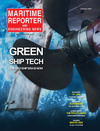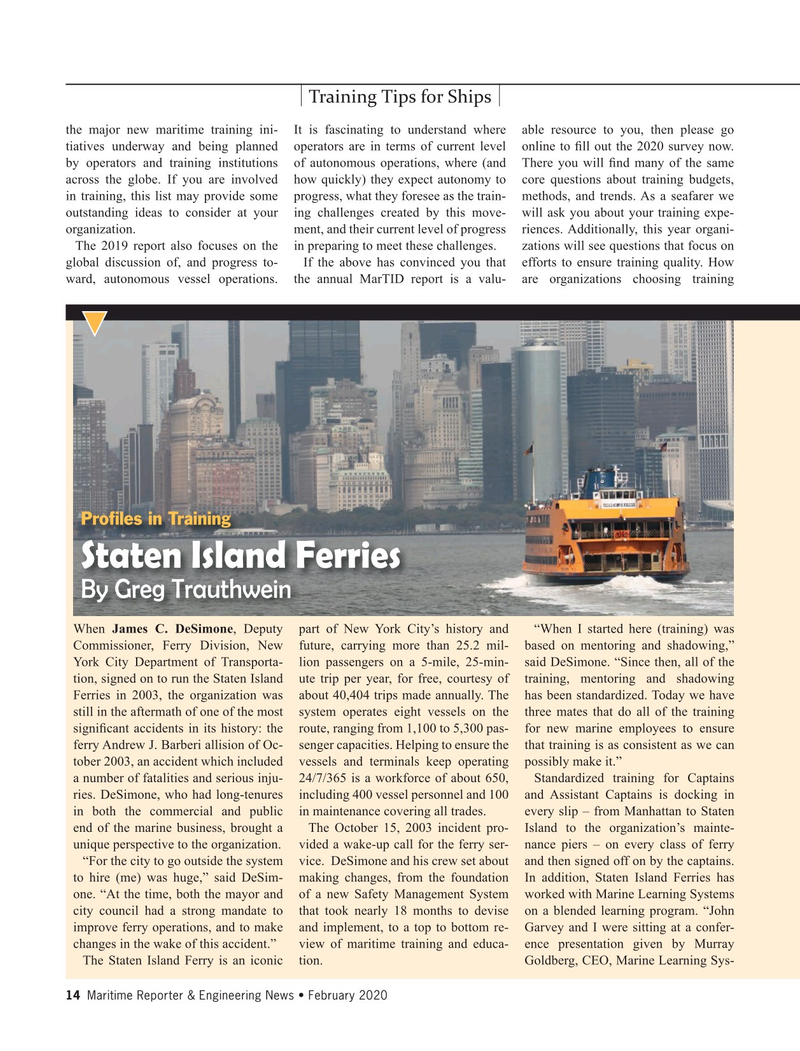
Page 14: of Maritime Reporter Magazine (February 2020)
Green Ship Technology
Read this page in Pdf, Flash or Html5 edition of February 2020 Maritime Reporter Magazine
Training Tips for Ships the major new maritime training ini- It is fascinating to understand where able resource to you, then please go tiatives underway and being planned operators are in terms of current level online to ? ll out the 2020 survey now. by operators and training institutions of autonomous operations, where (and There you will ? nd many of the same across the globe. If you are involved how quickly) they expect autonomy to core questions about training budgets, in training, this list may provide some progress, what they foresee as the train- methods, and trends. As a seafarer we outstanding ideas to consider at your ing challenges created by this move- will ask you about your training expe- organization. ment, and their current level of progress riences. Additionally, this year organi-
The 2019 report also focuses on the in preparing to meet these challenges. zations will see questions that focus on global discussion of, and progress to- If the above has convinced you that efforts to ensure training quality. How ward, autonomous vessel operations. the annual MarTID report is a valu- are organizations choosing training
Pro? les in Training
Staten Island Ferries
By Greg Trauthwein
When James C. DeSimone, Deputy part of New York City’s history and “When I started here (training) was
Commissioner, Ferry Division, New future, carrying more than 25.2 mil- based on mentoring and shadowing,”
York City Department of Transporta- lion passengers on a 5-mile, 25-min- said DeSimone. “Since then, all of the tion, signed on to run the Staten Island ute trip per year, for free, courtesy of training, mentoring and shadowing
Ferries in 2003, the organization was about 40,404 trips made annually. The has been standardized. Today we have still in the aftermath of one of the most system operates eight vessels on the three mates that do all of the training signi? cant accidents in its history: the route, ranging from 1,100 to 5,300 pas- for new marine employees to ensure ferry Andrew J. Barberi allision of Oc- senger capacities. Helping to ensure the that training is as consistent as we can tober 2003, an accident which included vessels and terminals keep operating possibly make it.” a number of fatalities and serious inju- 24/7/365 is a workforce of about 650, Standardized training for Captains ries. DeSimone, who had long-tenures including 400 vessel personnel and 100 and Assistant Captains is docking in in both the commercial and public in maintenance covering all trades. every slip – from Manhattan to Staten end of the marine business, brought a The October 15, 2003 incident pro- Island to the organization’s mainte- unique perspective to the organization. vided a wake-up call for the ferry ser- nance piers – on every class of ferry “For the city to go outside the system vice. DeSimone and his crew set about and then signed off on by the captains. to hire (me) was huge,” said DeSim- making changes, from the foundation In addition, Staten Island Ferries has one. “At the time, both the mayor and of a new Safety Management System worked with Marine Learning Systems city council had a strong mandate to that took nearly 18 months to devise on a blended learning program. “John improve ferry operations, and to make and implement, to a top to bottom re- Garvey and I were sitting at a confer- changes in the wake of this accident.” view of maritime training and educa- ence presentation given by Murray
The Staten Island Ferry is an iconic tion. Goldberg, CEO, Marine Learning Sys- 14 Maritime Reporter & Engineering News • February 2020
MR #2 (1-17).indd 14 2/5/2020 9:58:22 AM

 13
13

 15
15
